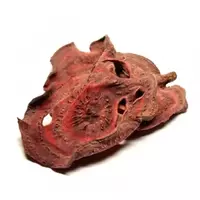Dried beets

Almost all types and varieties of vegetable and fruit crops, as well as berries, are widely used by humans not only for culinary purposes, but also in the treatment of a number of diseases. However, the main application of the fruits of various plants is still gastronomy.
It is noteworthy that you can eat them not only fresh, but also harvest them for future use using different methods of canning. This method of preserving the taste and beneficial properties of products means freezing, salting, fermentation, pickling, as well as drying. The latter canning option is suitable for almost all plant-based products, so it is widely used not only at home, but also in industrial production.
From vegetable crops, potatoes, onions and spring onions, carrots, garlic, horseradish and celery roots, as well as beets are most often harvested in this way. In industrial conditions, dried beets are made by subjecting root crops to pre-treatment and heat treatment, resulting in the finished product having the required moisture level, which contributes to the long-term preservation of dried beets.
Dried beets can be used at food enterprises for mass production of instant products, tomato sauce and ketchups, kvass, as well as meat pates and a number of dietary supplements (biologically active additives). In addition, in the food industry, dried beets in powder form are often used as a natural dye.
In general, dried beets come in two varieties - feather and second. In this case, the grade of this product is determined by parameters such as the number of veins and black dots. In addition, in the form of cutting, dried beets can be presented in the form of cubes, chips and plates.
In the reconstituted form, dried beets in cubes differ in the size of the sides of 5-10 millimeters. Standard plates of dried beets after swelling should be up to 4 millimeters in thickness with a diameter of up to 15 millimeters.
In addition, the consistency of the dried beet cubes is quite hard, while the chips and plates are brittle. The color of dried beets is represented by various shades of burgundy, which depends primarily on the root crop variety used in harvesting. After recovery (that is, boiling in liquid), one kilogram of dried beets corresponds to 6-8 kilograms of fresh root vegetable.
Since ancient times, beets and dishes based on it are considered unusually healthy and nutritious products. And today, dried beets are recommended to be consumed in order to arouse appetite and even raise mood. In addition, the inclusion of beets in any form in the diet contributes to the removal of toxins and slags from the human body.
dried beet 253.6 kCal
Energy value of dried beets (Ratio of proteins, fats, carbohydrates - ju):
Proteins: 9 g (~ 36 kCal)
Fats: 0.6 g (~ 5 kCal)
Carbohydrates: 56.6 g (~ 226 kCal)
Energy ratio (b | y): 14% | 2% | 89%
 Español
Español Français
Français Português
Português Русский
Русский 简体中文
简体中文 繁體中文
繁體中文 日本語
日本語 한국어
한국어 العربية
العربية Türkçe
Türkçe Қазақ
Қазақ Deutsch
Deutsch Italiano
Italiano Українська
Українська
